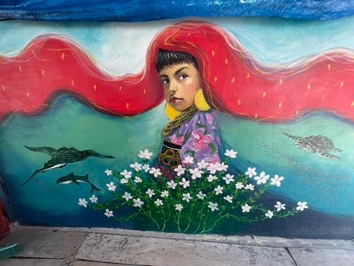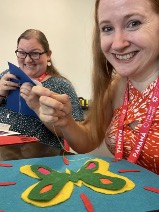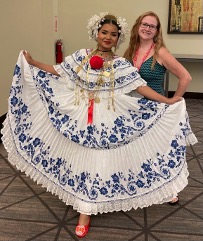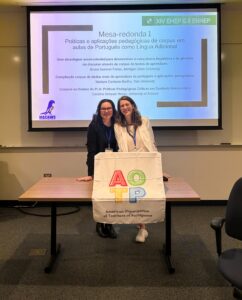Our incoming MAFLT student Jen Vogelsong attended the American Association of Teachers of Spanish & Portuguese (AATSP) in Panama this summer! As part of her Experiential Module, she shared her initial reflections about joining the MAFLT, going back to the classroom after 6 years and connecting to and learning from a wider teacher community at the conference!



Reflection by Jen Vogelsong, Spanish high school teacher based in Pennsylvania:
Teaching is hard and can be lonely work.
Sure, you have colleagues, but they may teach other levels or content.
Perhaps you don’t see them often, or don’t get along well.
Maybe they even have totally different ideas about what should be taught and how?
Then there is the reality of mediating between district requirements and standards and the needs of students and their families.
Not to mention wanting to keep your classes current and engaging; giving 100 percent every day without burning out.
If you are not connected, inspired, and engaged with current best practices, you won’t do the job well.
This is why, when I left teaching after six years in three different urban high schools, I said I’d never go back.
During my years of self-employment, I discovered that no matter what you are called to do, being connected, inspired and engaged with current best practices is key to doing any work well.
When I decided to jump back into teaching full time at my local high school mid-year, I knew I needed to get those three pieces in place, and fast.
I spent hours looking at graduate schools and master’s degree programs to find one I’d be excited to be part of (Hello awesome MAFLT community!) with coursework I couldn’t wait to engage with.
When my department coordinator told me this spring that I needed to join the American Association of Teachers of Spanish & Portuguese so that the school’s chapter of the Spanish Honor Society could continue, I saw that the organization held annual conferences. This summer it would be in Panama.
Panama?
I haven’t been to Panama. I know next to nothing about Panama (except that it has the canal).
I am still grieving the loss of flexibility to travel whenever I want now that I’m committed to a high school academic year schedule.
I want to go to Panama!
The prospect of spending four days connecting with other teachers from across the country who get excited about the same things I do enticed me.
At my high school, I am the only one who teaches Spanish IV and AP Language & Culture.
Attending the conference seemed like just the thing to get me connected, inspired and up to date on the latest in language teaching. My school wouldn’t pay for any of it (not even my membership in AATSP!) so I decided it would be an investment in myself and my summer vacation.
I was not disappointed.
The number and variety of sessions offered was incredible. My biggest problem was a bit of FOMO when sessions of interest were offered at the same time, forcing me to choose between them.
On several occasions, presenters did not show up, so while that was disappointing, it helped narrow my choices. The schedule was heavier on sessions geared toward the higher education community, but it did have many workshops relevant to K-12 and even early-childhood language programs.
I attended sessions on everything from artificial intelligence, current events, music, culture and authentic resources to how to hold silent conversations and run an engaging language program.
I felt like a kid in a candy store, trying to collect as many sweet bits as possible to bring home. I have so many ideas and things I want to do in my classroom. The challenge now that I’m back is to prioritize and focus so I don’t get overwhelmed.
I know from attending conferences when I was self-employed that if you don’t put the things you learned into place within a short time of returning to reality, you won’t get the full effect of your investment of time and money.
I’m thankful the conference was held during the summer months and that I’m enrolled in the MAFLT program, so I have both the time and structure to reflect on my experience in Panama and put pieces into place for my classes this coming school year.
Having come from a textbook background, working in a school with a grammar- and vocabulary-based curriculum, this conference was an important peek for me into other ways of doing things.
The challenge will be how much I’ll be able to do within the limitations of my district and department.
We won’t become a comprehensible input program, but I can make small changes to how I teach that incorporate elements of CI into my classes.
I can work to build a voluntary reading library and dedicate the first 10 minutes of class time twice a week to what I call “Lectura Libre,” or free reading.
I might not be able to rework my units to center around current events or music and culture themes, but I can be more intentional about incorporating them into my lessons and slowly shifting in that direction.
The research I’m reading and things I’m learning in my MAFLT classes, together with what I heard from colleagues at the conference, have given me the confidence to try new things and the backing I need to support my experimentation.
If I can collect enough evidence that these practices work, colleagues and the district may be more open to change. Even if they are not, I am still more connected, inspired and educated on best practices than I was eight months ago when I re-entered the profession.
The key for me will be to sustain the connection, inspiration and learning, so I continue to grow professionally.
When I feel like I’m learning and growing, connected with others and inspired, I am able to do more and better work. I can connect with students and colleagues without feeling burned out. I’m happier in the profession because it feels more like a calling and joy than a job.
If you have an opportunity to invest time and money into attending a professional conference, you will likely come back glad that you did.
During the years I ran my own business, I had an opportunity to attend a luncheon where Warren Buffett was our speaker.
I always remember him talking about how investments in yourself are never taxed and cannot be diminished by inflation. In big bold notes, I wrote down the line that stays with me to this day: “The best investment you can make is in yourself.”
